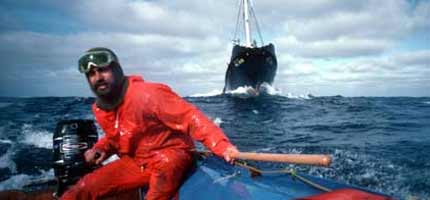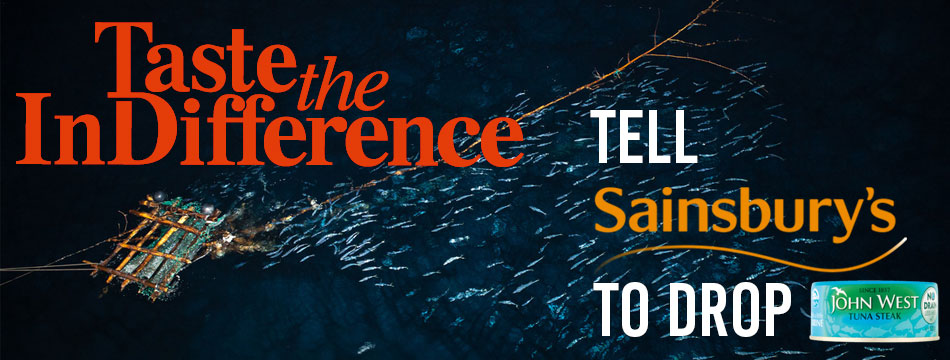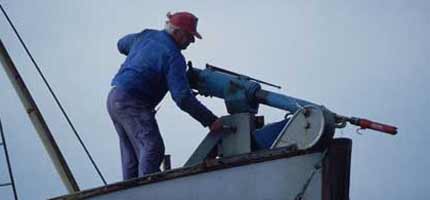
A Greenpeace volunteer in front of an Icelandic whaler
Commercial whaling during the last century decimated most of the world's whale populations. Estimates suggest that between 1925, when the first whaling factory ship was introduced, and 1975, more than 1.5 million whales were killed in total.
Whalers have hunted one whale population after another, moving from species to species as populations declined from exploitation. After repeated requests from the world community, the International Whaling Commission (IWC) agreed to a moratorium on commercial whaling that came into effect in 1986. Three countries continued to hunt whales: Norway, Japan and Iceland. But in 2007 Iceland finally renounced commercial whaling after admitting that there was no market for its whale meat.
The story so far:
| 1848: | Whaling enters the industrial age with the invention of the exploding harpoon. |
| 1905: | The introduction of factory ships leads to massive growth in the whaling industry. These floating processing plants are able to decimate whale populations at the rate of up to 40,000 a year. |
| 1930: | 80 per cent of the the great whale species are feared to be on the verge of extinction. |
| 1946: | The International Whaling Commission (IWC) is created by the world's 14 whaling nations to manage whale stocks. |
| 1972: | The number of blue whales, the largest creatures on the planet, sinks to less than 6,000. |
| 1975: | Greenpeace launches its anti-whaling campaign, confronting whaling fleets on the high seas. Faced with the realities of commercial whaling, public opinion begins to turn against the whalers. |
|
|
|
| 1979: | The anti-whaling lobby gains ground at the IWC, which establishes the Indian Ocean Whale Sanctuary as a practical conservation measure. |
| 1982: | The IWC establishes a moratorium on commercial whaling, taking effect from 1986. |
| 1983: | The Convention on International Trade in Endangered Species of Wild Fauna and Flora (CITES) bans international commercial trade in whale meat and confers protected status on the world's great whales. |
| 1987: | Japan begins its so-called "scientific" whaling programme. |
| 1990: | Seven out of the nine remaining whaling nations agree to abandon the industry. |
| 1993: | Norway lodges an objection to the moratorium and resumes commercial whaling, killing 500 minke whales per year. |
| 1994: | Southern Ocean Whale Sanctuary created to protect the great whales in their breeding grounds. Survey results show that over 5 million people go whale watching in 65 countries. This eco-tourism is actually more profitable than commercial whaling. |
| 1998: | Brazil proposes a Southern Atlantic Sanctuary. Australia and New Zealand propose South Pacific Sanctuary. |
| 1999: | Japan steps up its vote buying strategy at the IWC, and establishes a "blocking minority" to prevent the creation of a South Pacific Whale Sanctuary. |
| 2000: | Japan and Norway attempt to remove the protected status of whales at the CITES meeting in Nairobi in April 2000. If successful this would pave the way for a return to international trade in whale products.They fail by a narrow margin. |
| 1999/2000: | Greenpeace vessel MV Arctic Sunrise confronts Japanese whaling fleet in the Southern Ocean Sanctuary. 1999 The MV Sirius carries out similar work off the Norwegian coast. |
| 2001: | Whale watching is now a thriving industry in 87 countries, generating an income of US$1 billion worldwide each year. Japan admits to using overseas aid to buy support from developing nations for a return to commercial whaling. Greenpeace confronts the Japanese fleet and films a whale being harpooned in the Southern Oceans whale sanctuary. |
| 2002: | Japan uses votes bought from 14 other nations to block whale sanctuaries and deny indigenous peoples subsistence quotas - at the IWC meeting in Shimonoseki, Japan. Mexico creates the world's largest national whale sanctuary - in all of its EEZ (Exclusive Economic Zone) in the Pacific, Atlantic and Carribean Sea - to protect 21 species of cetaceans. Iceland is voted in as a full member of the IWC - despite refusing to follow the rules and despite their intention to resume whaling in 2006. |
| 2003: | Iceland resumes 'scientific' whaling - but as a response to international and domestic pressure, combined with a lack of demand for whale meat, the quotas are radically reduced from 200 whales of three species, to 61 whales of one species over two years. |
| 2005: | Japan and Norway both announce increases in their whaling quotas. Press reports suggest Japan will extend its Antarctic 'scientific' whaling to include the endangered Humpback and Fin species. |
| 2005/6: | Greenpeace attempts to stop the Japanese whaling fleet in the Southern Ocean, using two of its ships, the Esperanza and Arctic Sunrise. |
| 2006: | Japan finally wins a vote at the IWC and issues the "St Kitts Declaration", declaring a commitment to return the IWC to its original hunting mandate. |
| 2006: | Iceland officallly resumes commercial whaling, issuing permits for 39 kills - including nine endangered fin whales, despite no local demand for the meat and no possibility to export it. |
| 2007: | The St Kitts Declaration is decisively rejected at this year's IWC. Anti-whaling countries bounce back with a 37-4 vote for the CITES Resolution, strengthening the commercial whaling ban. |
| 2007: | Greenpeace again travels to the Southern Ocean to confront whaling. A tragic fire onboard the Government of Japan's whaling factory ship, the Nisshin Maru, in the Southern Ocean ends the whaling season prematurely. |
| 2007: | Iceland gives up whaling: in a setback to the whaling industry worldwide, Iceland's fisheries minister announces in August that he will not issue further commercial whale-hunting quotas. |
| 2007: | The Japanese 'scientific' whale hunt intends to add threatened humpback whales to its list of targets. |
| 2007: | In October Greenpeace links up with two scientific research bodies to tag and track humpback whales as they migrate from their breeding and calving areas in the tropical South Pacific to the feeding grounds of the Southern Ocean. Unlike the Japanese whalers, this provides genuinely useful data about humpback populations and behaviour. |
| 2008: | The Japanese government confirms a rumour first reported at the Greenpeace weblog, that they've abandoned plans to kill humpback whales in the Southern Ocean this season. |
| 2008: | In January our ship Esperanza chases the factory whaling ship Nisshin Maru across 5,000 miles of Southern Ocean and out of the Whale Sanctuary. During the two week chase no whaling takes place, saving the lives of around 100 whales. |



